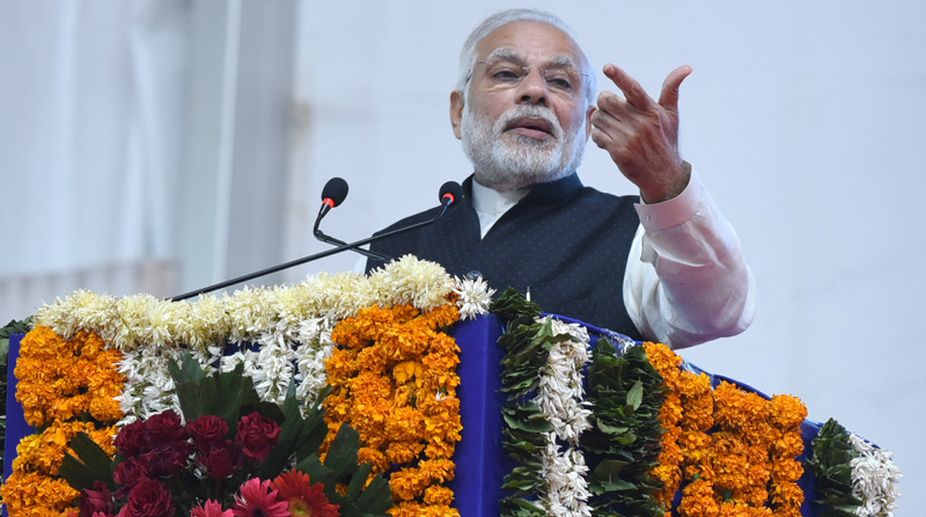Modi hopes to break 2014 and 2019 records under Yogi’s leadership
The prime minister hoped of an unexpected victory for the BJP in the 2024 Lok Sabha elections attributing it to CM Yogi's commitment to good governance and development.

Narendra Modi (Photo: Facebook)
The 15th ministerial level meeting of the Bay of Bengal Initiative for Multi-Sectoral Technical and Economic Cooperation (BIMSTEC) ended on 11 August in Kathmandu with the decision to conclude Free Trade Agreement and Grid Interconnection at the earliest.
The Indian External Affairs Minister Sushma Swaraj and junior foreign ministers of Thailand and Myanmar attended the meet. Nepal’s Prime Minister Sher Bahadur Deuba, while inaugurating the ministerial meet, hoped that it would endorse the regional cooperation framework on trade, investment and connectivity.
He stressed that in this age of globalisation and economic interdependence regional cooperation was not a choice but compulsion. He thus told member states, “BIMSTEC must give due attention to the different needs of its members in order to be effective as a regional grouping.”
Advertisement
Coincidentally, Nepal is chairing both BIMSTEC and SAARC (South Asian Association for Regional Cooperation). As per the scheduled 19th SAARC submit to have been held in Pakistan on November 9 and 10, 2016, Pakistan would have chaired SAARC.
But the submit was cancelled as India and some other nations refused to participate in the meet. Though Nepal is negotiating with the member countries, it is still uncertain when the next summit will take place. While chairing the two regional organizations, the role of Nepal appears to be limited for two reasons, internal and external.
Internally, Nepal is not in a position to discharge its role as it is passing through political transition. The constitution, which was promulgated in September 2015, is yet to be implemented fully, as provincial and federal parliamentary elections are still due. Although, two phases of local level elections are over, the third phase election is to be held on September 18.
The frequent changes of government testify to the fact that there is crisis of leadership. Externally, its limited economic and diplomatic resources handicap its maneuvering capacity in steering these regional organisations. Ironically, India despite being the main initiator and major stakeholder could not come up with success. India seemed to fail in providing leadership, as it was sceptical about the formation and role of SAARC from the very beginning, as most of its members were more or less in the Western bloc which was hostile to India.
Its performance was affected by intermittent ups and downs in Pakistan-India relations. Critics hold that SAARC was a non-starter as it was made hostage of India-Pakistan relations. Sri Lanka and Bangladesh could not remain unaffected by the cold war syndrome. Even after the restoration of democracy in Bangladesh, there were changes of government every five years.
Nepal too was not happy with India. Monarchy was not ready to part with its sovereignty. It wanted unqualified support from India. Later on, India’s stand underwent a change to support the democratic aspirations of people, which annoyed the monarchy.
To get rid of the neighborhood hostility, especially to keep Pakistan out of the conglomeration, and in accordance with India’s ‘Look East’ policy adopted by then PM PV Narsimha Rao, the concept of sub-regional cooperation was mooted. However, not to displease Pakistan, its boundary of south Asia was extended to the east by including two ASEAN nations, Thailand and Myanmar making BIMSTEC possible.
Unfortunately, BIMSTEC with its two decades of history too could not come up to the expectations of member states. Unfortunately, SAARC and BIMSTEC remained by and large rudderless, as their natural initiator India was unable to give direction to them. It might be for two reasons.
First,it took much time to record fast economic growth to rebuild its economy and provide economic support to its neighbours who were actually in need. Secondly, the internal political compulsions and personality clashes were also responsible for its poor performances. It seems that there is no Indian policy, only parties’ policy, as one party in power is ready to undo what an earlier regime had done.
Interestingly, during the early days of SAARC, any serious reader would recollect the assertion of then Sri Lankan President Jayawardene at the Kathmandu SAARC summit that the fate of South Asian region was safe under the leadership of Rajiv Gandhi. With its rapid economic growth, India’s policy of ‘Look East’ got impetus under Narasimha Rao.
With regard to improving relations with Bangladesh, the Teesta water sharing agreement was opposed by one party and the passing of the Land Boundary agreement obstructed by another major party, tarnished the image of India. Further, PM Narendra Modi’s criticism of previous Indian PMs for not visiting Nepal during the last 27 years, during his address to the Nepalese parliament was appreciated as if he were not part and parcel of the Indian establishment. The policy of ‘Neighbourhood First’, which was initiated by PM Modi, has remained unimpressive from its very beginning.
By inviting all heads of state of SAARC to be present at the swearingin ceremony of PM Modi, India showed its superiority. Although, it was just a change of government, yet they all participated. Participation of SAARC leaders at a swearing-in ceremony cannot be made a convention and it cannot be reciprocated.
Similarly, sending its foreign secretary to Nepal with a message to halt the passage of the new Constitution at the eleventh hour showed its lack of wisdom. Thus, it seems that only if the interests of India prevail, will it provide able leadership to regional and international organisations.
(The writer, a former Election Commissioner of Nepal, is associated with the Nepal Transition to Peace Institute.)
Advertisement